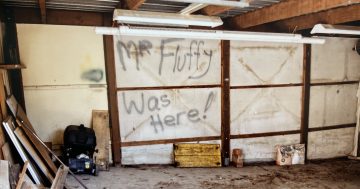
The horrific Grenfell Tower fire on 14 June 2017 killed 72 people. Photo: Creative Commons.
When Mr Fluffy was discovered as a dangerous and lethal form of insulation, the ACT Government undertook remediation work to rid affected homes of the danger, following the audit by the Commonwealth Government before self-government was achieved.
Unfortunately, some homes were missed, leading to a buy-back scheme by the government (via a $1 billion loan from the federal government) where homeowners were compensated and either purchased established homes or built new homes.
The feeling in the community was that this was a reasonable undertaking by the government. It was not the fault of the homeowner that the material was not fit for purpose.
Fast forward to the Grenfell Tower fire in the UK in 2017 where its cause and subsequent loss of life were traced back to flammable external cladding and insulation behind the cladding.
This led governments worldwide to undertake audits of apartment complexes to identify similar problems.
Jurisdictions in Australia have handled this issue in a variety of ways. In the UK, grants were made to affected entities to resolve the issue.
In Canberra, and unlike Mr Fluffy homes, the remediation of flammable cladding on apartment complexes has become the responsibility of apartment owners (via their body corporate). While the offending cladding was installed at a time when it was legal and was therefore cleared by government-approved building certifiers, nobody knew what was coming.
There is a requirement for all complexes to remove offending cladding and replace it with material that will ensure owners are not harmed should there be a fire. It seems that in most cases, not only is the cladding no longer fit for purpose, but the way it was affixed to buildings is also non-compliant.
Fair enough, we all say, people must be safe in their homes. But the removal and replacement costs are almost prohibitive – just as they were throughout the Mr Fluffy ordeal.
The cladding must be replaced – insurance will become impossible to purchase without replacement. In our case, our insurer will only provide insurance in six-month blocks pending completion of the rehabilitation.
We are told the ACT Government has approved our complex for a “generous” loan to undertake the work. The interest rate is 4.2 per cent. The loan comes with a number of strings attached – for example, the body corporate must have a minimum of 10 per cent contingency for the work, the offending cladding must be recycled and evidence of how it is recycled is to be provided etc.
This building work is the largest private remediation in the ACT, at an eye-watering cost of $15 million. This means that every owner will be required to pay tens of thousands of dollars annually for many years to come. In our instance, we are not far off $100,000 as our share of the costs. And costs may rise depending on labour and material availability.
Within our community, many continue to shake their heads and wonder whether this issue is any different from Mr Fluffy. After all, the use of the cladding was legitimate and approved when the building was constructed and passed fit for occupancy. That is identical to Mr Fluffy.
Why, then, in the ACT, are apartment owners being treated in this fashion? We are no different from Mr Fluffy owners. Because we are apartment dwellers, it doesn’t mean that we have access to more funds than others. Indeed, many apartment dwellers have downsized and are working at living within their means.
The imposition of these enormous costs on owners leaves more than a bad taste in the mouth. The imposition of other costs (interest rates, excess costs for recycling, contingency funds, etc) is an outrageous overstep by the ACT Government.
None of this story covers the anxiety caused to owners, nor the incredibly challenging time ahead whereby “wrapped” scaffolding will cover the building until the task is complete in around 18 months.
This whole process should be incredibly embarrassing – for politicians and bureaucrats alike.
At the very least, the government should not be charging interest on the loan provided. The government should take responsibility for recycling the offending cladding. These actions would go some way to mitigating the fact that there is no equity between Mr Fluffy owners and “bad cladding” owners.
Robert and Helen Goddard are residents of the ACT.




















